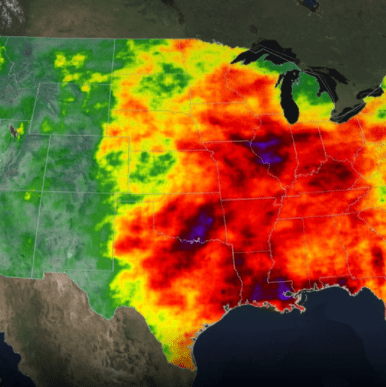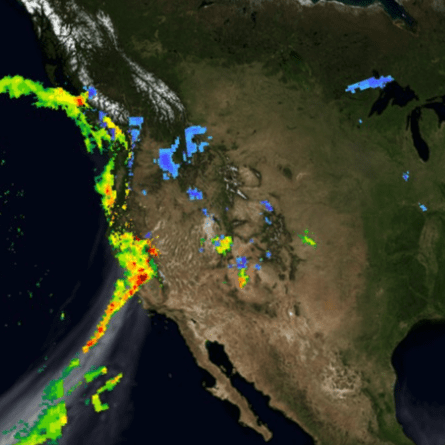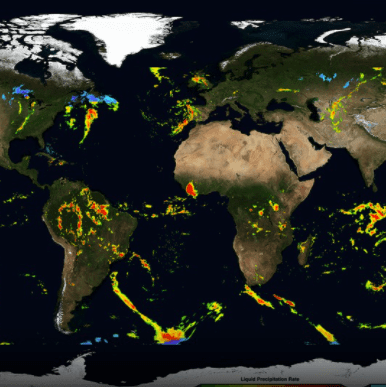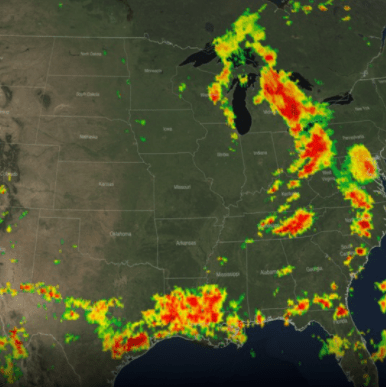6.3 Weather, Climate & Water Cycling
Why does a lot of hail, rain, or snow fall at some times and not others?
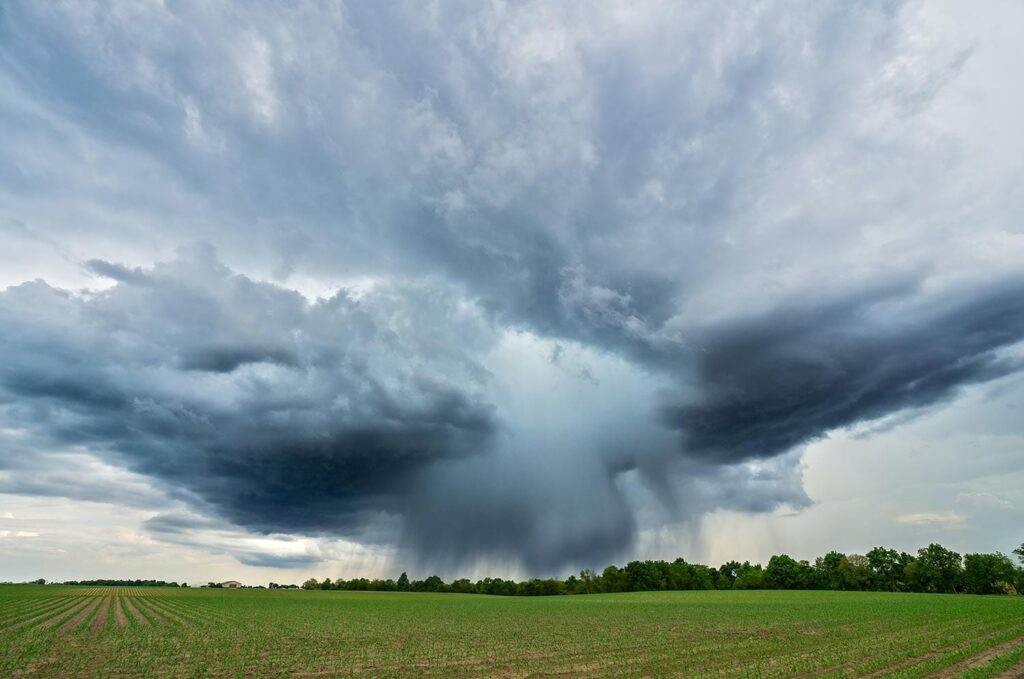
Unit Summary
This 6th grade science unit on weather, climate, and water cycling is broken into four separate lesson sets. In the first two lesson sets, students explain small-scale storms. In the third and fourth lesson sets, students explain mesoscale weather systems and climate-level patterns of precipitation. Each of these two parts of the unit is grounded in a different anchoring phenomenon.
The unit starts out with anchoring students in the exploration of a series of videos of hailstorms from different locations across the country at different times of the year. The videos show that pieces of ice of different sizes (some very large) are falling out of the sky, sometimes accompanied by rain and wind gusts, all on days when the temperature of the air outside remained above freezing for the entire day. These cases spark questions and ideas for investigations, such as investigating how ice can be falling from the sky on a warm day, how clouds form, why some clouds produce storms with large amounts of precipitation and others don’t, and how all that water gets into the air in the first place.
The second half of the 6th grade science weather and climate unit is anchored in the exploration of a weather report of a winter storm that affected large portions of the midwestern United States. The maps, transcripts, and video that students analyze show them that the storm was forecasted to produce large amounts of snow and ice accumulation in large portions of the northeastern part of the country within the next day. This case sparks questions and ideas for investigations around trying to figure out what could be causing such a large-scale storm and why it would end up affecting a different part of the country a day later.

Simulations
Unit Examples
Additional Unit Information
Next Generation Science Standards Addressed in this Unit
Performance Expectations

This 6th grade science unit on weather and climate builds toward the following NGSS Performance Expectations (PEs):
- MS-PS1-4: Develop a model that predicts and describes changes in particle motion, temperature, and state of a pure substance when thermal energy is added or removed.
- MS-ESS2-4: Develop a model to describe the cycling of water through Earth’s systems driven by energy from the sun and the force of gravity.
- MS-ESS2-5: Collect data to provide evidence for how the motions and complex interactions of air masses results in changes in weather conditions.
- MS-ESS2-6: Develop and use a model to describe how unequal heating and rotation of the Earth cause patterns of atmospheric and oceanic circulation that determine regional climates.
Disciplinary Core Ideas

The 6th grade science weather and climate unit expands students’ understanding of weather and climate, and the role of water in Earth’s surface processes which include these grades 6-8 elements of the Disciplinary Core Ideas (DCIs). It addresses all but the crossed-out sections of the ones shown below.
ESS2.C: The Roles of Water in Earth’s Surface Processes
- Global movements of water and its changes in form are propelled by sunlight and gravity.
- The complex patterns of the changes and the movement of water in the atmosphere, determined by winds, landforms, and ocean temperatures and currents, are major determinants of local weather patterns.
- Variations in density due to variations in temperature
and salinitydrive a global pattern of interconnected ocean currents. - Water continually cycles among land, ocean, and atmosphere via
transpiration, evaporation, condensation and crystallization, and precipitation,as well as downhill flows on land.
ESS2.D: Weather and Climate
- Weather and climate are influenced by interactions involving sunlight, the ocean, the atmosphere, ice, landforms,
and living things.These interactions vary with latitude, altitude, and local and regional geography, all of which can affect oceanic and atmospheric flow patterns. - Because these patterns are so complex, weather can only be predicted
probabilistically. - The ocean exerts a major influence on weather and climate by absorbing energy from the sun, releasing it over time, and globally redistributing it through ocean currents.
This unit builds on DCI elements that students should have developed in the prior OpenSciEd unit 6.2. These ideas are elicited and are used in new contexts (primarily different because of time and temporal scale). In many cases, the unit helps students extend these DCIs. The plain text beneath each of the DCI elements below describes how the ideas are used and where they are extended.
- PS1.A: Structure and Properties of Matter: Gases and liquids are made of molecules or inert atoms that are moving about relative to each other. In a liquid, the molecules are constantly in contact with others; in a gas, they are widely spaced except when they happen to collide. In a solid, atoms are closely spaced and may vibrate in position but do not change relative locations.
- This particle model is reused and extended in Lessons 3-11, 13-14, and 17-18. It is used to model (1) how energy is transferred from the ground to the air (through conduction), (2) why air changes its density (due to changes in the speed of air particles), (3) why density would affect the amount of air pressure detected by a barometer (due to differences in the amount of force applied to the barometer from changes in the weight of a column of air particles overhead), and (4) how the cooling of water vapor in the air can cause the molecules in it to slow down enough that they stick to, rather than bounce off of, neighboring particles in collisions, thereby causing the particles to condense or solidify out of the air.
- PS3.A: Definitions of Thermal Energy: The temperature of a system is proportional to the average internal kinetic energy and potential energy per molecule (whichever is the appropriate building block for the system’s material). When the kinetic energy of an object changes, there is inevitably some other change in energy at the same time.
- The idea that thermal energy transfer can occur through conduction is used to explain how the air above the ground is heated by it, and how warm rising air cools off as it moves higher up, This idea is reused in Lessons 5-8, 10, 12, 13, 14, 17, 18, 20, and 22.
- PS4.B: Electromagnetic Radiation When light shines on an object, it is reflected, absorbed, or transmitted through the object, depending on the object’s material and the frequency (color) of the light.
- The idea that light is absorbed by the ground and converted to thermal energy is an idea that is reused in Lessons 3, 6-8, 10, 14, 17, 18, 20, and 22 in this unit.
Disciplinary Core Ideas are reproduced verbatim from A Framework for K-12 Science Education: Practices, Crosscutting Concepts, and Core Ideas. DOI: https://doi.org/10.17226/13165. National Research Council; Division of Behavioral and Social Sciences and Education; Board on Science Education; Committee on a Conceptual Framework for New K-12 Science Education Standards. National Academies Press, Washington, DC.
Science & Engineering Practices

- Developing and Using Models
- Planning and Carrying Out Investigations
- Analyzing and Interpreting Data
Crosscutting Concepts

- Patterns
- Cause and Effect
- Systems and System Models
- Matter and Energy
Connections to the Nature of Science

Which elements of the Nature of Science are developed in the unit?
- Science investigations use a variety of methods and tools to make measurements and observations. (NOS-SEP)
- Science investigations are guided by a set of values to ensure accuracy of measurements, observations, and objectivity of findings. (NOS-SEP)
- Science depends on evaluating proposed explanations. (NOS-SEP)
- Science knowledge is based upon logical and conceptual connections between evidence and explanations. (NOS-SEP)
- Science assumes that objects and events in natural systems occur in consistent patterns that are understandable through measurement and observation. (NOS-CCC)
How are they developed?
- Students engage with different tools (i.e., thermometers, light sensors, humidity probes, barometers, and simulations) to make measurements and observations.
- Students develop and use color gradient based visualization methods for rendering weather data from across the country to look for patterns across space and over time.
- Students discuss how they will collect measurements and observations during their use of light detectors and thermometers in outdoor settings to ensure the data set is accurate.
- Students critique a computer simulation of a thunderstorm to determine the mechanisms that cause storms to form and suggest revisions to the interface to make such concepts more transparent to the user.
- Students evaluate which model ideas for explaining small-scale weather events might help explain predicted precipitation patterns in a mesoscale weather system.
- Students compare and critique arguments about what would cause the predicted weather changes in a mesoscale weather system to identify whether they emphasize similar or different mechanisms.
- Students apply scientific ideas and related evidence to evaluate whether those mechanisms are also needed to explain how the weather will change for three other storms occurring at a different time of year.
Unit Placement Information
What is the anchoring phenomenon and why was it chosen?

This unit uses two anchors, one to drive student questions and investigations in the first half of the unit, and one to drive student questions and investigations in the second half of the unit. The unit begins with students watching, in three short video clips of relatively short precipitation events, hail falling at different locations in North America at different times of year. Students develop initial models to explain what causes this kind of precipitation event to occur, considering (1) the changes that happen over time where the hail falls, (2) the changes that occur to matter in the air at a particle level, and (3) the energy that transfers into, through, and out of the system. They expand the range of phenomena by considering other times when they’ve seen or heard of a lot of precipitation fall in one place in either a relatively short time (minutes) or continuously over a much longer time (hours or days). Students then develop a Driving Question Board (DQB) to guide future investigations.
The second half of the unit re-anchors in the context of a larger-scale weather event in Lesson 14. It begins with students watching a winter weather report and forecast clip from the Today show (from 8:00 a.m. (EST) on Saturday, Jan. 19, 2019) and analyzing maps for most of the United States,. Students evaluate their previously developed model ideas for explaining the causes of a hailstorm to determine whether the same causes also help explain how what happened in the air over the country at the time of the forecast was connected to what was predicted to happen by the end of the weekend (40 hours later), which includes some areas that went on to receive over a foot of snow accumulation and other areas that received over half an inch of ice accumulation. Students then add new questions to their Driving Question Board (DQB) to guide future investigations. The second half of the video from the same forecast is then introduced in Lesson 18, to support a transition to climate-related questions and investigations in the last few lessons of the unit.
Each OpenScied unit’s anchoring phenomenon is chosen from a group of possible phenomena after analyzing student interest survey results and consulting with external advisory panels. We also chose hail as the first anchoring phenomenon for this unit for these reasons:
- Severe weather events provided a compelling context for explaining weather-related phenomena. Hailstorms fell into this category, and explanations for them did not require model ideas that were beyond the target DCIs for the middle school level, which something like tornadoes would require.
- The relatively sudden and brief window of a hailstorm event (up to about 15 min in length) and relatively small impact area (a few miles) provided a more tractable scale system to begin investigating how changes in the matter flow and energy transfer into the air can drive the formation of storms, before moving on to larger-scale weather system (mesoscale) and climate-related patterns (hemisphere scale) in the later half of the unit.
- A pre-field test release of this anchor produced Driving Question Boards that had over 85% of the students’ questions on them as well as ideas for investigations to answer those questions. These investigations were anticipated by the unit development team, and were specifically targeted in the field test version of the storyline.
- A subsequent piloting of this anchor confirmed that this type of weather event was intriguing for students who had varying levels of firsthand experience with hail. This included those who experienced hail relatively frequently (classrooms in the midwest), as well as for those who encountered it far less frequently (classrooms on the west coast) and those who had neither encountered nor heard of it before (some international students).
We also chose a video of a winter storm weather report and forecast from Jan., 19, 2019 as the phenomenon to re-anchor the second half of this unit for these reasons:
- The video clip included weather reporting and forecasts for the western, central, and eastern United States. This broad area of impact provides regional connections to most students in the country.
- Related predictions, regarding a potential loss of energy due to the effect of freezing rain on downed power lines and the forced closing of schools in the northeast, provide a severe winter storm context that has an impact on the related activities that students engage in.
- The four extratropical cyclones covered in the forecast are examples of mesoscale (synoptic) low pressure weather systems. These systems commonly occur in the middle latitudes of the Earth (e.g., the United States) across multiple seasons of the year. These, in combination with anticyclones of high-pressure air, drive much of the weather changes that students experience – capable of producing a myriad of weather events, including cloudiness and mild showers to heavy gales, thunderstorms ,and blizzards.
- The differences in the predicted precipitation across different regions from all of these storm systems reveal some new patterns related to coastal proximity, elevation, and prevailing winds. These patterns provide a context to start exploring climate-oriented questions, which are also part of the target DCIs for this unit.
Where does this unit fall within the OpenSciEd Scope and Sequence?

This unit is designed to be taught after students have experienced the One-way Mirror Unit and the Cup Design Unit. As such, work in this unit can leverage ideas about the interaction of light with matter as well as the particle nature of matter and how energy can be transferred through particle-level collisions (conduction).
This unit is designed to be taught prior to the Everest Unit, in which students will leverage ideas about how thermal energy transfer can result in the movement of matter. It is also designed to be taught prior to the Storms Unit, in which students will leverage ideas about how to predict, detect, and respond to natural hazards relevant to their local context, many of which are likely to be severe weather related. Finally, it is designed to be taught prior to the Everest Unit, in which students will leverage ideas about what causes climate-level precipitation patterns to develop a model to help explain why the climate may be changing and what we can do to address some of those causes and mitigate the impacts of such changes.
How is the unit structured?

The unit is organized into four lesson sets that begin with figuring out a short-term, small-scale hail storm and slowly build into larger storm systems and global circulation systems.

What modifications will I need to make if this unit is taught out of sequence?

This is the third unit in 6th grade in the OpenSciEd Scope and Sequence. Given this placement, several modifications would need to be made if teaching this unit earlier or later in the middle school curriculum. These include the following adjustments:
- If taught before OpenSciEd Unit 6.2, supplemental teaching of the following would be required:
- Gases and liquids are made of molecules or inert atoms that are moving about relative to each other. In a liquid, the molecules are constantly in contact with others; in a gas, they are widely spaced except when they happen to collide. In a solid, atoms are closely spaced and may vibrate in position but do not change relative locations.
- The temperature of a sample of matter is proportional to the average internal kinetic energy per molecule in that sample.
- When the kinetic energy of a particle object changes, there is inevitably some other change in energy at the same time; kinetic energy can be transferred from one particle to another through particle collision. This form of energy transfer (conduction) can occur between solid, liquids and gases when they make contact with each other.
- When light shines on an object, it is reflected, absorbed, or transmitted through the object, depending on the object’s material and the color of the light. Energy from the light that is absorbed by a sample of matter is converted to increased particle motion energy in that sample of matter.
- The total kinetic energy of particles in a sample of matter is also referred to as the thermal energy of that matter.
- Identifying independent and dependent variables and controlling for other variables, can help you conduct fair tests, which is a necessary condition for producing data that can serve as the basis for evidence in supporting or refuting a potential cause and effect relationship in a system.
- If taught before OpenSciEd Unit 6.1 (or at the start of the school year), supplemental teaching of classroom norms, setting up the Driving Question Board, and asking open-ended and testable questions would need to be added. Experience with using light sensors and reading and interpreting their output would need to be added.
What are prerequisite math concepts necessary for the unit?

In this unit, students will need to have prior experiences in working with the ideas in the bolded sections of the related Common Core Math Standards listed below.
CCSS.MATH.CONTENT.6.NS.C.5: Understand that positive and negative numbers are used together to describe quantities having opposite directions or values (e.g., temperature above/below zero, elevation above/below sea level, credits/debits, positive/negative electric charge); use positive and negative numbers to represent quantities in real-world contexts, explaining the meaning of 0 in each situation.
CSS.MATH.CONTENT.6.NS.C.8: Solve real-world and mathematical problems by graphing points in all four quadrants of the coordinate plane. Include use of coordinates and absolute value to find distances between points with the same first coordinate or the same second coordinate.
CCSS.MATH.CONTENT.6.RP.A.2: Understand the concept of a unit rate a/b associated with a ratio a:b with b ≠ 0, and use rate language in the context of a ratio relationship.
CCSS.MATH.CONTENT.6.RP.A.3: Use ratio and rate reasoning to solve real-world and mathematical problems, e.g., by reasoning about tables of equivalent ratios, tape diagrams, double number line diagrams, or equations.
Additionally, when students generate and interpret the tables of data in Lessons 2, 4, and 11, they will draw on what they have learned across a number of Represent and Interpret data standards for grades 1-5, within the domain of Measurement and Data in the Common Core Mathematics Standards.
How do I shorten or condense the unit if needed? How can I extend the unit if needed?

The following are example options to shorten or condense parts of the unit without completely eliminating important sensemaking for students:
- Since, in many ways, one can think of this unit as two units in one – where Lesson sets 1 and 2 are anchored around a small-scale weather phenomenon, and Lessons sets 3 and 4 are anchored around large-scale weather phenomenon and long-term patterns (climate level), one natural end point for the unit would beat the end of Lesson 13, which is the end of Lesson set 4.
- Since the focus of Lesson set 4 is on climate-level phenomena, rather than weather-related ones, another natural end point for the unit would be toward the end of Lesson 18, which is the end of Lesson set 3. If you end here, then modify the second half of day 2 of Lesson 14 so the focus is taking stock of the progress the class feels they made on the Driving Question Board again, as was done at the end of Lesson 13, rather than eliciting new questions and ideas for investigations, which is what is outlined in the learning plan.
To extend or enhance the unit, consider the following:
- Lesson 1: You could replace one of the first two videos of hail with a local example, to establish stronger local relevance. However, keep the third video (timelapse) as it shows changes in the air overhead, which most other videos will not.
- Lesson 2: You could ask students to start tracking changes in local weather conditions where they live to look for additional patterns over time.
- Lesson 6: You could ask students to start tracking instances of vertical cloud growth they see in the weather outside.
- Lesson 11: You could give interested students the opportunity (and some of the materials needed) to build their own homemade barometer and ask them to track changes in air pressure over subsequent days.
- Lesson 13: If hurricane season impacts your area more than extratropical cyclones tend to, you could extend the unit to investigate how ocean temperatures, currents, and prevailing winds influence the formation of hurricanes and typhoons around the world. If you include a focus on how these systems interact with other air masses, this will provide an alternate pathway to cover mesoscale weather phenomena and some climate-level patterns in precipitation, which is the focus of Lessons 14-22. Keep in mind that such a modification to the unit will require a relatively large time investment in pre-development before it is ready to be implemented in the classroom.
Unit Acknowledgements
Unit Development Team

- Michael Novak, Unit Lead, Northwestern University
- Renee Affolter, Writer, Boston College
- Emily Harris, Writer, BSCS Science Learning
- Audrey Mohan, Writer, BSCS Science Learning
- Lindsey Mohan, Writer, BSCS Science Learning
- Dawn Novak, Writer, BSCS Science Learning
- Tracey Ramirez, Writer, The Charles A. Dana Center, The University of Texas at Austin
- Abe Lo, Reviewer, BSCS Science Learning
- Katie Van Horne, Assessment Specialist
- Colleen O’Brien, Pilot Teacher, Williston Central School
- Heather Galbreath, Pilot Teacher, Lombard Middle School
- Vanessa Hannana, Pilot Teacher, Indian Woods Middle School
- Whitney Smith, Pilot Teacher, Indian Woods Middle School
- Ann Rivet, Unit Advisory Chair, Teachers College, Columbia University
- Elisabeth Cohen, Advisory Team, Weather Outreach
Production Team

BSCS Science Learning
- Kate Herman, Copyeditor, Independent Contractor
- Stacey Luce, Copyeditor and Editorial Production Lead
- Renee DeVaul, Project Coordinator and Copyeditor
- Valerie Maltese, Marketing Specialist & Project Coordinator
- Chris Moraine, Multimedia Graphic Designer
Unit External Evaluation
EdReports

EdReports awarded OpenSciEd an all-green rating for our Middle School Science Curriculum in February 2023. The materials received a green rating on all three qualifying gateways: Designed for the Next Generation Science Standards (NGSS), Coherence and Scope, and Usability. To learn more and read the report, visit the EdReports site.
NextGenScience’s Science Peer Review Panel

An integral component of OpenSciEd’s development process is external validation of alignment to the Next Generation Science Standards by NextGenScience’s Science Peer Review Panel using the EQuIP Rubric for Science. We are proud that this unit has been identified as a quality example of a science unit. You can find additional information about the EQuIP rubric and the peer review process at the nextgenscience.org website.

Unit standards
This unit builds toward the following NGSS Performance Expectations (PEs) as described in the OpenSciEd Scope & Sequence:
- MS-ESS2-4
- MS-ESS2-5
- MS-ESS2-6
- MS-PS1-4*
Reference to kit materials
The OpenSciEd units are designed for hands-on learning and therefore materials are necessary to teach the unit. These materials can be purchased as science kits or assembled using the kit material list.



